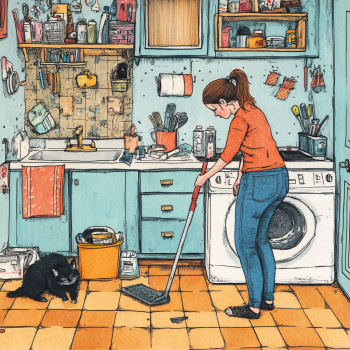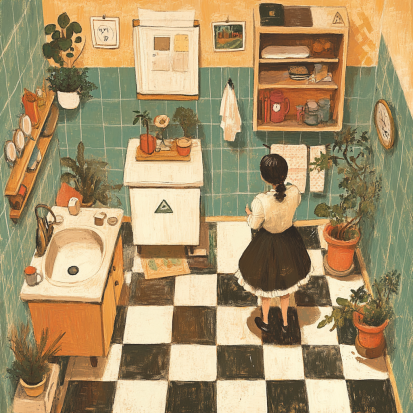Fostering Responsibility and Independence

When children transition into their tween years, typically between the ages of 10 and 12, they begin to experience a heightened sense of independence and responsibility. This stage of development is the perfect opportunity to introduce more structured chores, as tweens are eager to take on new challenges and contribute more meaningfully to the household. However, the key to success lies in making sure the chores are appropriate for their age, engaging enough to hold their interest, and balanced so they don’t feel overwhelmed by their new responsibilities.
At this age, children are ready to take on more complex tasks, but it’s crucial to approach chore management in a way that fosters their growing autonomy without creating unnecessary pressure. The solution? A well-thought-out, age-appropriate chore chart. Not only does a chore chart provide structure, but it also encourages responsibility and time management, while incorporating an element of fun to keep your tween motivated.
Create an effective chore chart that empowers your tween to take ownership of their daily and weekly tasks, balance their chores with schoolwork and extracurricular activities, and develop lifelong habits that will serve them well into adulthood. From choosing the right tasks to keeping motivation high, this guide will help you foster independence in your child while ensuring that chores become a positive part of their routine.

Why Chore Charts Work for Tweens
Chore charts serve as more than just a basic to-do list; they are valuable tools that help tweens develop essential life skills such as time management, accountability, and self-discipline. At this stage in their development, children are increasingly capable of tackling more complex and varied tasks, but they still require structure to navigate their responsibilities effectively.
A thoughtfully designed chore chart provides that necessary structure, ensuring that chores complement rather than disrupt their academic commitments, hobbies, and social lives. By offering a visual representation of their tasks and expectations, chore charts make it easier for tweens to understand what is required of them each day. This clarity helps them manage their time better and fosters a sense of autonomy.
Moreover, as they check off completed tasks, tweens experience a sense of accomplishment and pride in their contributions to the household. This immediate feedback can boost their motivation and reinforce positive behaviors, making chores feel less like a burden and more like an integral part of their growing independence. Ultimately, chore charts can empower tweens to take ownership of their responsibilities while helping them build confidence and self-reliance.

Step 1: Choosing Age-Appropriate Tasks
At 10-12 years old, tweens are ready to take on more significant household responsibilities, but the key is to match chores with their growing abilities. Here are some examples of age-appropriate chores:
- Daily Chores: Making their bed, tidying their room, putting away laundry, setting or clearing the dining table.
- Weekly Chores: Taking out the trash, vacuuming, cleaning the bathroom sink, organizing their closet.
- Advanced Chores: Cooking simple meals, folding laundry, mowing the lawn, or caring for a pet.
By giving your tween tasks that require focus and follow-through, you’re helping them learn essential skills like problem-solving, following instructions, and even critical thinking. However, the tasks shouldn’t be so difficult that they feel frustrated or discouraged.
Personal Tip: When my eldest daughter reached this age, we sat down and brainstormed together which chores she felt comfortable taking on. This collaborative approach made her feel involved and more willing to help out around the house.
Step 2: Balancing Chores with Schoolwork and Extracurriculars
Tweens typically juggle a busy schedule filled with schoolwork, homework, and extracurricular activities such as sports or music lessons. For a chore chart to be effective, it’s essential to consider these existing commitments and create a plan that balances their responsibilities without overwhelming them.
Create a Flexible Schedule: The key is flexibility. If your child has soccer practice twice a week, assign fewer chores on those days, but balance it out with extra tasks on weekends or lighter school days. Make sure they understand that some chores are daily (like feeding the dog), while others can be spread throughout the week.
Use a Family Calendar: Incorporating chore time into a shared family calendar can help tweens visualize how their chores fit alongside school, hobbies, and free time. You can also use apps like Cozi or Google Calendar, which allow everyone in the family to see what’s on the schedule.
Personal Insight: In my household, we use a color-coded calendar to keep track of each child’s activities and chores. It’s been a lifesaver, especially during the busy school year. When my daughter sees her schedule laid out visually, it’s easier for her to prioritize and manage her time.
Step 3: Printable Templates for Easy Tracking
Creating a chore chart doesn’t have to be complicated. In fact, using printable templates can streamline the process. You can find free chore chart templates online that are customizable and designed for different age groups. You can print them out or even laminate them for repeated use.
If your child prefers something more interactive, try using a magnetic or dry-erase board that they can update daily. You can also opt for a digital solution by using apps that track chores, where kids can check off tasks and even receive points or rewards virtually.
Chore Chart Template Ideas:
- Daily Checklists: Simple, straightforward checklists where kids mark off completed chores each day.
- Weekly Charts: A weekly overview where kids can see all their tasks at a glance, ensuring they can plan ahead.
- Reward-based Charts: Charts that track progress toward rewards, which can be non-monetary, like extra screen time or a family movie night.
Step 4: Rewards vs. Intrinsic Value
One of the greatest challenges for parents is maintaining their tweens motivation to consistently complete chores. While offering rewards can be a helpful short-term strategy, it’s equally important to nurture a sense of responsibility and encourage intrinsic motivation. Teaching tweens to find satisfaction in contributing to the household and taking pride in their accomplishments will foster long-term commitment to their tasks, beyond the immediate gratification of rewards.
Reward Systems: Many parents use a reward system where kids earn points, money, or privileges for completing chores. While this can be a great short-term motivator, it’s important to avoid over-rewarding for tasks that should eventually become routine. Instead, use rewards for extra chores or exceptional effort.
Teaching Intrinsic Value: As tweens mature, they should also begin to understand the intrinsic value of helping out at home. Explain how their contributions help the family and prepare them for adulthood. Encourage them to take pride in their work by emphasizing that chores aren’t just tasks, they’re life skills that will benefit them in the long run.
Personal Reflection: In my family, we initially used a reward system, but as my daughter grew older, we transitioned to focusing on the importance of responsibility. By 12, she began to take pride in her accomplishments without needing a reward. It took time and patience, but seeing her take initiative was incredibly rewarding for both of us.

Empowering Tweens Through Responsibility
Creating an age-appropriate chore chart for your tween is about more than just getting the house clean. It’s about teaching responsibility, time management, and independence. By giving your child tasks that match their abilities, balancing their schedule, and motivating them to succeed, you’re setting them up for success both at home and beyond.
As you design a chore chart, remember to involve your child in the process and be flexible with adjustments along the way. With a little planning and the right tools, you can empower your tween to take charge of their responsibilities, while building confidence and character.
Tips:
- Use chore chart templates to make organization easy and fun.
- Balance chores with schoolwork using a family calendar or app.
- Gradually shift focus from rewards to the intrinsic value of responsibility.
Recommended Tools:
- Free printable chore charts from sites like Canva or Template.net.
- Family organization apps like Cozi or ChoreMonster.
Teaching tweens how to manage their responsibilities now will pay off in the long term, and the sooner you start, the sooner you’ll both reap the rewards. By introducing chore charts and instilling habits of accountability and independence early on, you’re helping your child develop crucial life skills that will serve them well into adulthood. Learning how to balance responsibilities with other aspects of life, such as school and extracurricular activities, sets a foundation for effective time management, work ethic, and even self-discipline.
As your tween grows, these skills will evolve, making it easier for them to handle more complex challenges, from managing school projects to balancing future jobs and personal commitments. It’s about more than just getting chores done, it’s about fostering a sense of ownership, responsibility, and pride in their contributions.
Starting early also allows you as a parent to gradually step back and watch your child flourish in their independence, building their confidence along the way. The reward isn’t just a clean room or a chore well done; it’s seeing your child grow into a capable, responsible individual. So, take the time now to set up a structured routine, work through challenges, and encourage your tween’s progress. You’ll both benefit from this investment in the long run, as you’ll see them thrive at home and beyond.








